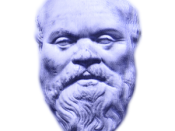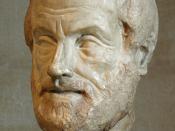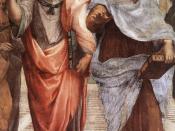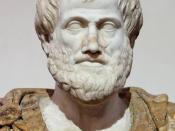Aristotle (384-322BCE), a student of Plato, had numerous students and he actively took part in teaching them as well as learning and studying along with them. Aristotle was indeed a unique person. His writings and teachings covered an extremely wide range of topics. The reason Aristotle took on so many topics was his hungry pursuit of the knowledge of reality and understanding all aspects of, not only human existence, but worldly existence as well.
The following will prove why it is necessary to understand form and matter in order to understand reality by looking at Aristotle's Physics. Careful attention will be given to Book I Chapter Seven and Book II Chapters One through Three. The conclusion will be gained that without first understanding form and matter, one can never truly know reality or understand the reasons things are the way they are.
The discussion of form and matter is found in Book I Chapter Seven of Physics.
This chapter begins by identifying three ways of describing a change. The three ways of describing change are "a man comes to be musical, that the not-musical thing becomes musical, and that the not-musical man comes to be a musical man"ÃÂ (189b34-190a2).
Each of these three ways of describing change can be used to make a different point. The first example shows that there is something, the non-musical man, that goes through a change. The change is that the man becomes musical. The second example implies that there was a lack of a certain state, which was changed to possess that state. This change is shown by something that is not musical actually producing music. This is of course, caused by the man, but the man is not being examined in the second example. Only what was not musical and then becomes musical is examined. The third example combines the first two points by saying that the man who is not musical becomes a musical man. The single change can actually be viewed as three separate changes.
Aristotle refers to the state that things are in as their form. This holds true in the case of the man becoming musical. In this example, the form is a state of knowledge. This knowledge is not just knowing facts about music, but the skills needed in order to understand and produce music. These skills are found in one's soul and the ability to use these skills is a physical change. Therefor in the example of a man becoming musical, changes took place both in the soul of the man as well as physically.
When something that is not musical becomes musical there are also changes happening. If an object, such as a guitar is sitting on a table without anyone or anything acting upon it, then it is not musical. However this guitar becomes musical as soon as someone who has the knowledge and skills to produce music on a guitar begins to do so. The guitar really can not be musical without the help of this person, just as the person can not produce music without the guitar.
In the example of the man who is not musical and then becomes a musical man, there is a factor other than form identified. This factor is that certain things persist or hold true through change. "The man, for instance, remains a man and is still a man when he becomes musical"ÃÂ (190a11-13). The man is still a man even though he has undergone a change from being not musical to musical. Only the aspect of being musical or not has changed for the man. This change could affect other aspects of the man, but the fact is, physically the man is still a man.
In Book II of Physics, Aristotle continues to examine form and matter, looking for answers regarding reality. In Chapter One he presents the idea that some things are natural and other things are due to causes. This means that something's form is either natural, like plants and animals, or produced, like a bed or crafts. Next, Aristotle examines the nature of things such as a bed. One argument is that the wood in a bed is matter because the wood in the bed is from a tree and the wood in the bed will not produce another bed. On the other hand, the argument can be made that the bed is form. The wood makes up the nature of the bed and is a part of the bed. Without the wood the bed would not be a bed (193a15-21).
Aristotle argues that form is closer to nature than matter. He feels that one needs to look at what something is becoming, not just what it is coming from. Aristotle thinks that people should study "nature in two ways-both as form and as matter"ÃÂ (194a12-13). He is saying that people should examine things as to what they appear to be, as well as what they are made up of.
In Chapter Three of Book II, perhaps the most complex question is posed. The question is, why is something (a statue or a bowl) what it is (a statue or a bowl)? This question can only be answered by examining four causes. These four causes, identified by Aristotle, are material, formal, efficient, and final (195a16-27). The first two causes, material and formal, have previously been discussed in Aristotle's examination of form and matter. The ideas of form and matter are examined further as causes along with the second two causes, efficient and final.
The material cause is the idea that in every change, there is something that receives a new definition. This is saying that the original object is no longer the same, it has undergone a change that altered the original material state of the object. An example of this can be found with a sculptor and a block of stone. The sculptor shapes the block of stone by chipping away until the block of stone is no longer a block of stone, but a sculpture made of stone. The Idea that the sculpture is made of stone exemplifies the idea of prime matter (195a33-195b3). Without prime matter it would have to be accepted that anything could be changed to anything. Prime matter puts constraints on this idea. Prime matter is found in everything, but never found alone. It is the underlying "stuff"ÃÂ that makes up everything. It is basically the potential for all change.
Everything is composed of matter, but also made up of form. The formal cause explains why a thing is the kind of thing it is. Matter is potential while form is actual. In the case of natural things, form determines things such as what species an animal is. An animal such as a cat may change throughout its life, but the fact is, it is still a cat. A cat can not become a snake and the formal cause explains this.
The question that arises from form has to do with death. If something's form is dependent on its soul, how is death explained? The efficient cause explains that there must be a source for any motion or change. In the example of the block of stone becoming a sculpture, the sculptor is the source of change (195b10-13). This is only external efficient cause. It is internal efficient cause that explains death. Just as the sculptor is the source of motion that causes change in the previous example, the soul is the source of internal motion that causes change such as growth and even death (195b16-23).
The final question that is produced is, why does any of this motion occur? Aristotle answers this question with the final cause. The final cause is the purpose motion takes place. In the example of the sculptor, the reason the sculptor is sculpting and causing motion is to produce a sculpture (195b27-28). In nature, the final cause is not so easily explained. Going back to the example of the bed, which is made of wood, the tree that produced the wood did not grow to be made into a bed. It grew to live and produce more trees. The eventual fate of the tree can be explained by the idea that there is a cause at work. This cause ultimately has to be traced to some type of force much greater than even Aristotle could fully understand. Whether people rationalize this force as God is up to the individual.
Aristotle's Physics is a discussion of a wide range of topics. Throughout the discussion the ideas of form and matter are kept at the forefront. Physics ends with an argument for the existence of "unmoved movers"ÃÂ (258b12), which are souls that originate motion. The idea of an unmoved mover may very well be Aristotle's equivalent to God. The ideas of form and matter are prevalent as key themes all throughout Physics. Thy are absolutely necessary in order to examine reality and answer the question, why are things the way they are?





